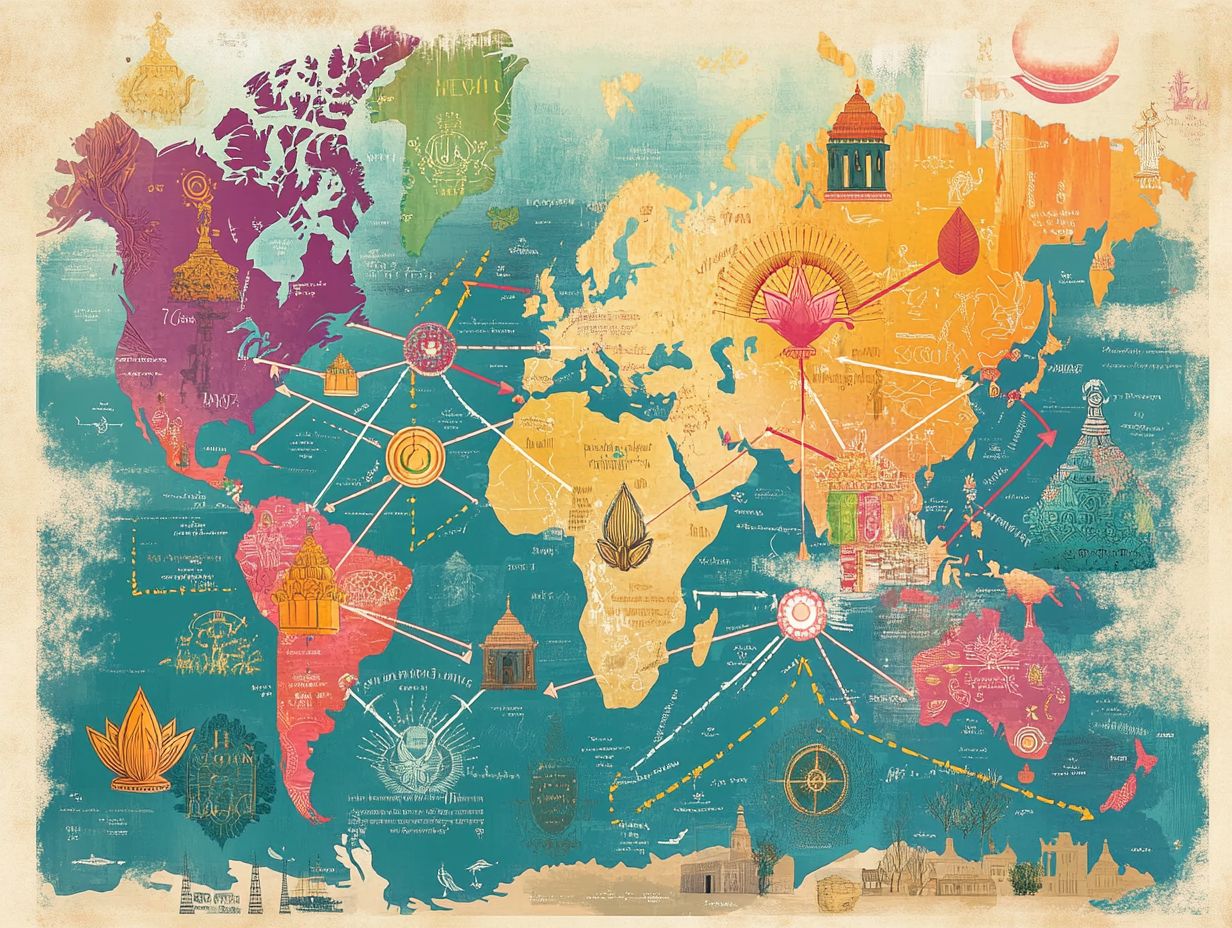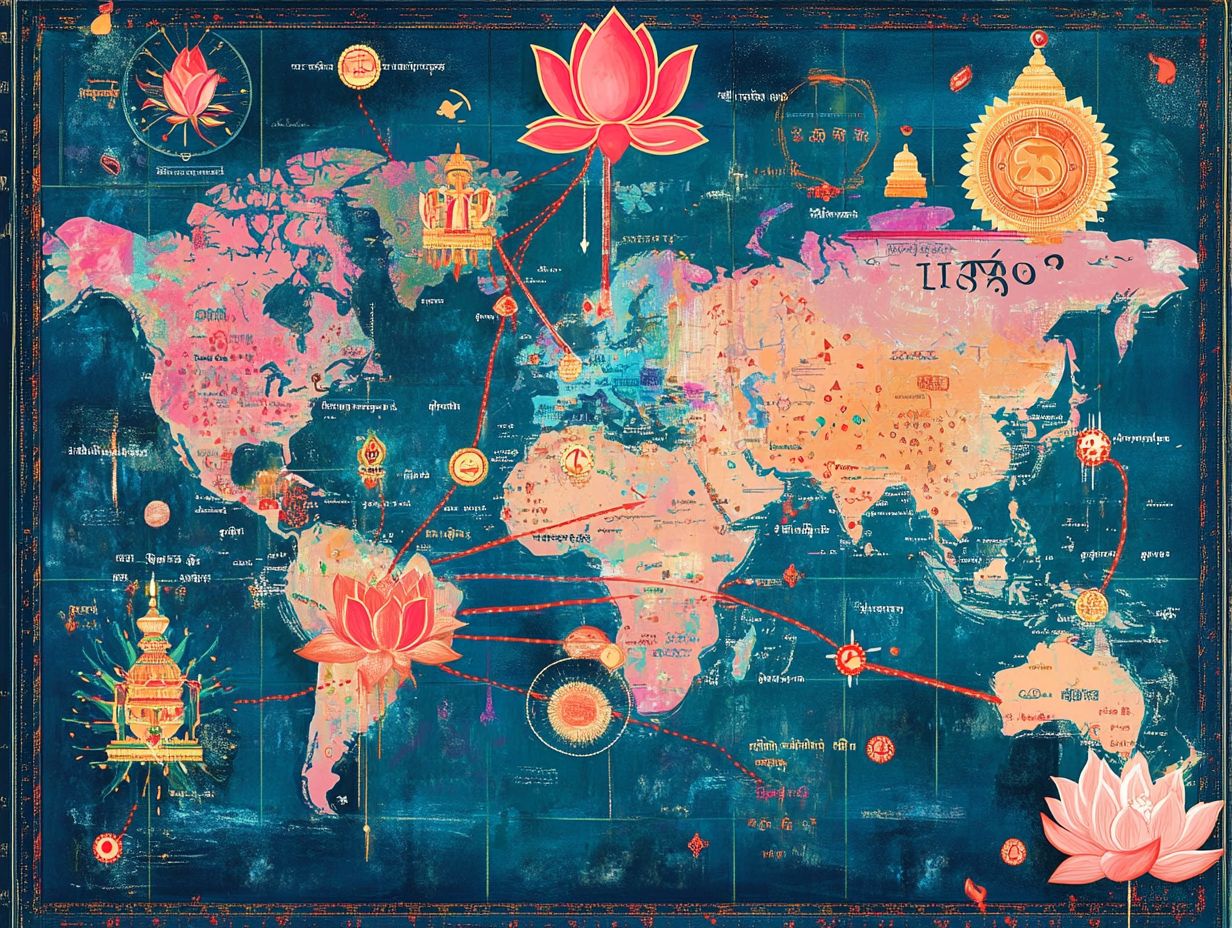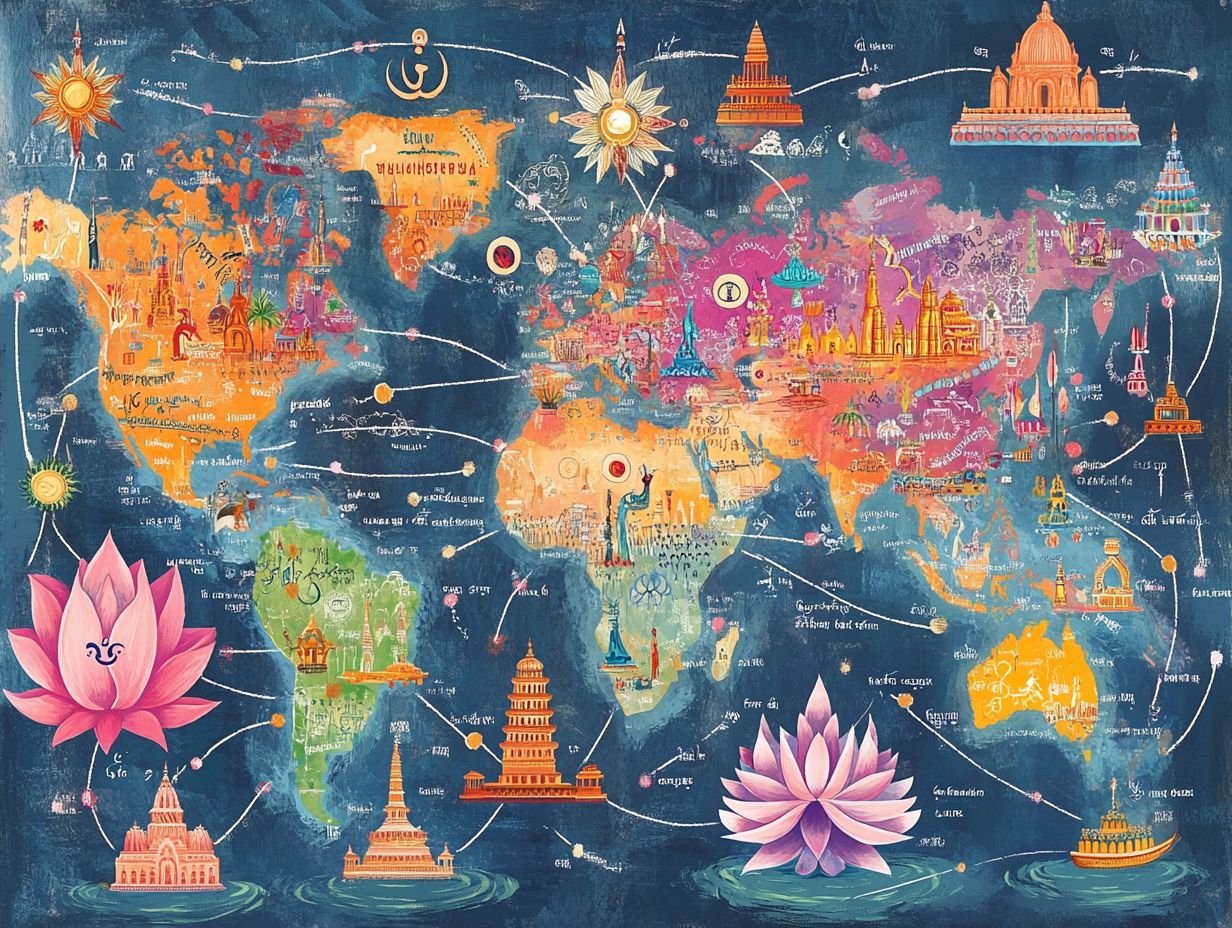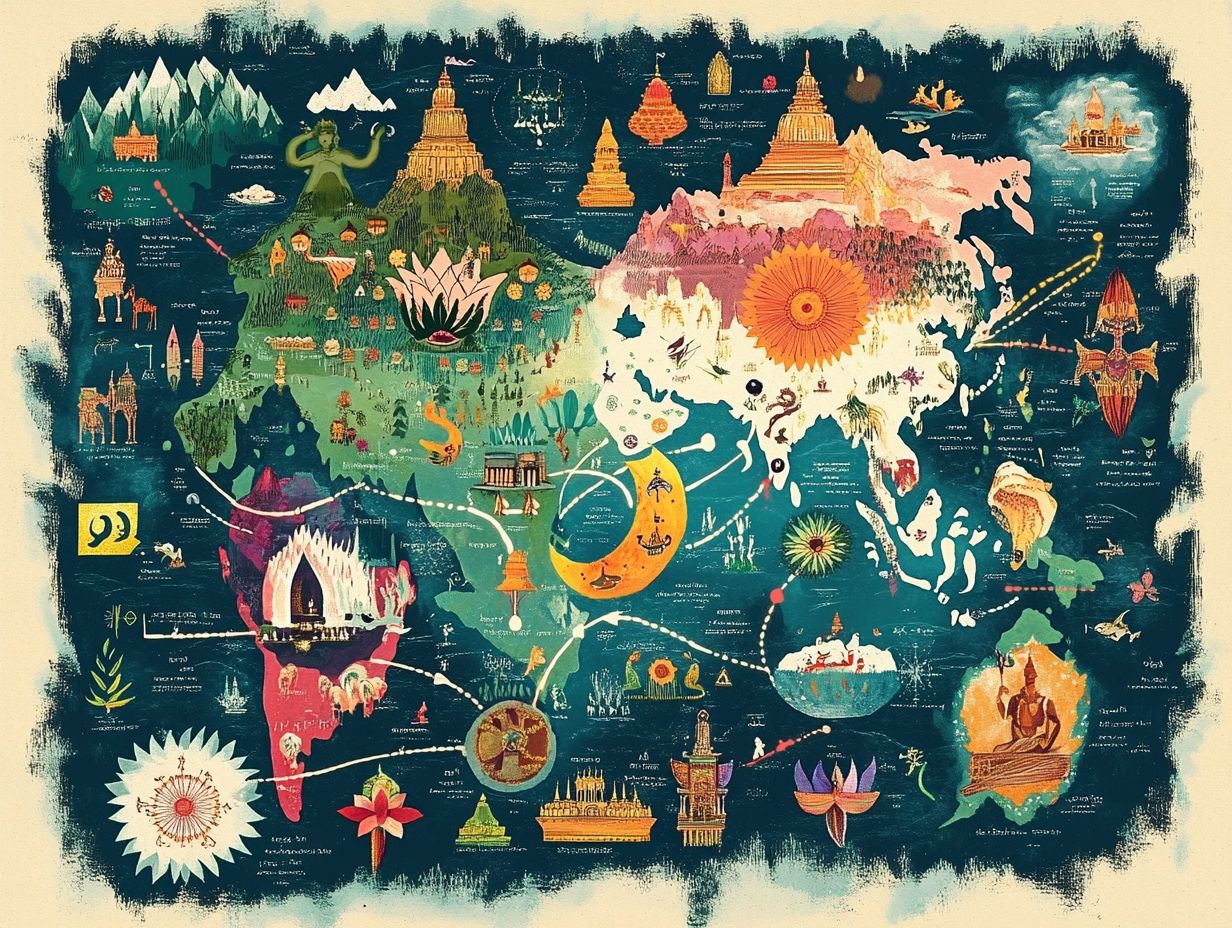How Has Hinduism Diffused?
Hinduism, recognized as one of the oldest religions in the world, presents a rich tapestry of beliefs, practices, and traditions that have evolved over countless millennia, encompassing rituals, customs, and sacred texts.
Emanating from the Indian subcontinent, this multifaceted faith has transcended its geographical origins, significantly influencing cultures across Southeast Asia, East Asia, and even extending its reach to Europe and North America through migration and cultural diffusion.
Examining the origins of Hinduism, its principal branches, and the trajectories of its diffusion unveils the resilience of its core tenets and highlights its remarkable adaptability and cultural integration within a swiftly changing global landscape.
This exploration invites a deeper understanding of Hinduism’s journey, tracing its evolution from ancient roots to its dynamic presence on the world stage today, influenced by globalization and colonialism.
What is Hinduism?

Hinduism, recognized as one of the world’s oldest religions, embodies a vast and diverse spectrum of beliefs and practices, deeply rooted in the ancient traditions and philosophies of the Indian subcontinent. This religion is distinguished by its profound emphasis on spirituality, ethics, karma yoga, and the relentless pursuit of truth.
It weaves a rich tapestry of rituals, festivals, and sacred texts, including the revered Vedas and Upanishads. Additionally, Hinduism delves into the intricate concepts of dharma, karma, and reincarnation, which profoundly influence the lives of its adherents across various communities in India, Nepal, and among the global Hindu diaspora. Yoga and meditation are also vital practices that enhance spiritual growth and self-realization.
Where Did Hinduism Originate?
Hinduism finds its origins in the Indian subcontinent, particularly in the area that is now recognized as modern-day India. Here, ancient civilizations like the Indus Valley civilization laid the foundational stones for a rich tapestry of cultural exchange and religious practices that would profoundly evolve over millennia, influencing regional variations and ethnic communities.
This vibrant cultural milieu was intricately shaped by the interplay of various social, political, and economic factors, leading to the diverse manifestations of Hinduism that are observable today, marked by syncretism and cultural adaptation.
The historical roots of this ancient religion can be traced to significant migrations and interactions among different groups across the region. As these populations traversed the subcontinent, they carried with them unique traditions and beliefs, which organically blended with the indigenous practices of the land, leading to a rich cultural identity.
This confluence of cultures fostered the emergence of various regional traditions, resulting in distinct practices within Hinduism, from the elaborate rituals of South India to the rich philosophical schools flourishing in the North, illustrating the diversity and regional variations within the faith.
Over the centuries, external influences most notably from the Persians and later the Mughals further enriched the religious landscape of Hinduism. This adaptability and incorporation of diverse elements have proven pivotal to Hinduism’s enduring legacy, illustrating its remarkable capacity to evolve while maintaining core tenets and promoting religious tolerance.
How Did Hinduism Spread?
The journey of Hinduism from its origins in India to various corners of the globe is a remarkable narrative of diffusion, unfolding through a myriad of channels such as migration, trade routes, and cultural exchanges propelled by globalization and historical colonialism. This religious spread has led to the establishment of Hindu communities abroad.
Each wave of dissemination introduced distinctive adaptations and interpretations, enabling Hindu beliefs and practices to thrive within a rich tapestry of diverse cultural contexts, promoting cultural integration and intercultural exchange.
1. Through Migration and Trade
Migration and trade have been instrumental in the spread of Hinduism, as dedicated communities traversed vast regions, bringing with them their beliefs, rituals, and traditions, which subsequently intertwined with local customs across the globe. This complex interplay has given rise to vibrant Hindu diaspora communities that not only celebrate their cultural heritage but also adapt seamlessly to new environments, fostering religious pluralism and social harmony.
For instance, Indian merchants navigating the maritime routes to Southeast Asia forged strong connections that enabled Hinduism to thrive in locales such as Bali and Indonesia. Iconic structures like the Prambanan Temple stand as enduring symbols of this cultural exchange, showcasing a harmonious blend of local architectural styles and Hindu design elements, embodying Hindu art and architecture.
As Hindu communities established themselves in places like Trinidad and Guyana, they introduced their vibrant festivals, including Diwali and Holi, which have become integral to local celebrations. The globalization of these traditions fosters a distinctive blend of identities, where Hindu practices coexist with indigenous customs, enriching the cultural tapestry of these diverse regions and promoting social justice.
2. Through Conquest and Colonization
The expansion of Hinduism was profoundly shaped by the conquests and colonization of various regions, where military and political power acted as catalysts for the introduction of Hindu beliefs and practices into new territories. This led to a remarkable process of cultural diffusion and integration within local societies. These historical events not only reshaped social structures but also transformed religious landscapes, allowing Hinduism to leave an indelible mark on diverse cultures, fostering coexistence and harmony.
Military campaigns and trade expeditions served as vital conduits, facilitating the exchange of goods alongside the dissemination of ideas, rituals, and philosophical understandings, which were often adapted to align with local customs. For instance, the establishment of Hindu kingdoms in Southeast Asia, such as the Majapahit Empire in Indonesia, showcased the intermingling of Hindu practices with indigenous traditions. This synthesis created a unique cultural dynamic, encouraging local populations to embrace and incorporate Hindu principles within their societal frameworks. This process also highlights the role of sacred geography, where temples and holy sites became focal points of cultural and religious integration.
The interactions between different faiths introduced complexities in religious expression, as diverse beliefs confronted one another. This led to a tapestry of both conflict and mutual enrichment, a phenomenon evident in artistic endeavors and the evolution of spiritual practices across various regions. Interfaith dialogue has been crucial in fostering mutual understanding and religious tolerance.
3. Through Religious Conversion

Religious conversion has served as a significant conduit for the dissemination of Hinduism, with individuals and communities embracing its teachings through interfaith dialogue and mutual understanding. This has fostered a degree of assimilation that enriches the tapestry of local religious pluralism. The dynamic interplay between Hinduism and other faiths has created a unique environment where diverse beliefs are able to coexist harmoniously, promoting social harmony and cultural heritage.
This phenomenon is particularly noticeable in regions where Hindu rituals and practices have been interwoven with those of indigenous and other religious communities. The process of conversion encompasses not only the adoption of new beliefs but also a profound transformation of cultural practices, often resulting in strengthened community bonds. In various parts of India, for example, festivals originally rooted in other faiths have evolved to incorporate Hindu elements, illustrating a mutual influence at work. This syncretism has helped sustain religious tolerance and enrich the cultural fabric of society.
Such interactions highlight how religious conversion can shape the identities of communities, fostering respect and collaboration among differing faith traditions. Ultimately, this process benefits the broader society by promoting peaceful coexistence and understanding among diverse groups.
What Are the Major Branches of Hinduism?
Hinduism is distinguished by its remarkable diversity, encompassing several major branches, each presenting unique interpretations, practices, and philosophies that encapsulate the multifaceted essence of the religion. These branches reflect the rich cultural and historical context within which Hinduism has evolved, accommodating various sects and traditions.
Among the most notable branches are Vaishnavism, Shaivism, and Shaktism, each devoted to different deities and embodying distinct rituals and ethical teachings. This intricate branching weaves a complex tapestry of beliefs, catering to a broad spectrum of spiritual seekers.
1. Vaishnavism
Vaishnavism, one of the most widely embraced branches of Hinduism, is centered on the veneration of Vishnu and his revered avatars, including Rama and Krishna. This tradition places a significant emphasis on devotion (bhakti) as a fundamental path to spiritual fulfillment. Its elaborate tapestry of rituals, festivals, and profound philosophical teachings reflects a deep reverence for the divine and the earnest pursuit of dharma. The Bhakti movement, which emphasizes loving devotion, played a crucial role in the spread and popularization of Vaishnavism.
The philosophy of Vaishnavism is rooted in the belief in the inherent goodness of life and the profound connection between the individual soul (atman) and the supreme soul (Brahman). In this framework, loving devotion serves as a vital bridge toward liberation (moksha). Devotees actively immerse themselves in practices such as chanting sacred names, performing puja, and participating in vibrant community festivals. These activities not only deepen their connection to the divine but also foster a strong sense of belonging among fellow practitioners. Temples and places of worship serve as focal points for these communal gatherings and spiritual activities.
Through these rituals, devotees express their gratitude, seek guidance, and reaffirm their commitment to living in alignment with the teachings of their cherished deities, ensuring that their spiritual journeys remain both vibrant and fulfilling.
2. Shaivism
Shaivism represents a prominent branch of Hinduism, venerating Shiva as the supreme being and embodying a profound spiritual philosophy that delves into the duality of existence. This tradition places great emphasis on meditation and asceticism as essential pathways to achieve liberation (moksha). Distinctive rituals and practices characterize Shaivism, establishing a deep connection to sacred texts like the Vedas and Upanishads, as well as a rich mythology.
Followers of Shaivism immerse themselves in a variety of practices designed to cultivate a meaningful relationship with the divine. These include intricate rituals that honor Shiva through offerings, chanting, and communal worship. The theological implications of this tradition extend far beyond simple devotion; they inspire spiritual journeys that encourage adherents to investigate the nature of reality, exploring concepts such as karma, dharma, and the self.
Meditation plays a central role in this exploration, enabling individuals to transcend ordinary consciousness and gain profound insights into the divine presence. Through these avenues, the practitioners of Shaivism engage in practices like yoga and pilgrimage to sacred places, fostering transformative experiences that nurture their spiritual growth and promote a sense of unity with the cosmos.
3. Shaktism
Shaktism venerates the divine feminine, placing the goddess Shakti at the forefront as the quintessential energy and creative force that permeates the universe. This tradition underscores the vital role women play in both spiritual practice and community life. Through a rich tapestry of rituals and festivals, Shaktism cultivates a profound spirituality centered on rituals and the manifestation of divine energy.
In this context, the goddess transcends mere veneration; she embodies essential cosmic principles, highlighting the importance of feminine energy within Hindu philosophy. Devotees participate in rituals such as puja, which pays homage to various forms of Shakti, including Durga and Kali, each representing distinct facets of strength and nurturing. These practices are deeply rooted in sacred texts like the Vedas and Upanishads.
Festivities like Navaratri a vibrant celebration dedicated to the goddess feature nine nights filled with worship, dancing, and feasting, illustrating the joyous and transformative essence of feminine energy within communal life. This practice establishes a nurturing space where individuals can awaken spiritually and embrace rituals and ceremonies, solidifying their connection to the divine.
How Did Hinduism Diffuse to Other Parts of the World?

The spread of Hinduism, often referred to as religious diffusion, illustrates how religious beliefs, practices, and cultural aspects have traveled far from their origins in India.
The diffusion of Hinduism across the globe represents a complex interplay of historical, social, and political dynamics that have facilitated the migration of peoples and ideas. This intricate process has led to the establishment of vibrant Hindu communities in regions such as Southeast Asia, East Asia, Central Asia, Europe, and North America. To understand how fast Hinduism spread, one can observe the enduring influence of Hinduism in its rituals, practices, and the establishment of temples, showcasing its adaptability and resilience.
As Hinduism has spread, it has inspired unique adaptations and expressions, enriching its global presence and ensuring its relevance in diverse cultural contexts today. To understand how Hinduism spread in India, one can explore major texts like the Vedas, Upanishads, and core concepts such as karma, dharma, and reincarnation that have influenced numerous cultures.
1. Southeast Asia
The presence of Hinduism in Southeast Asia can be traced back to ancient trade routes and cultural exchanges that facilitated the dissemination of Indian influence throughout the region. This led to the establishment of flourishing Hindu kingdoms and the creation of magnificent religious architecture, including temples and sculptures that pay homage to Hindu deities. The historical legacy of this influence continues to resonate in contemporary practices, such as the Bhakti movement and various pilgrimage routes.
In Indonesia, particularly in Bali, Hinduism presents a unique amalgamation of local customs and ancient traditions, evidenced by ceremonies that honor deities and celebrate agricultural cycles. Similarly, Cambodia s Angkor Wat stands as a monumental testament to the architectural brilliance inspired by Hindu beliefs. Other regions, such as Thailand, seamlessly weave Hindu motifs into their royal traditions.
These adaptations exemplify a dynamic relationship in which local cultures embrace and reinterpret Hindu customs, showcasing how this ancient religion has intricately intertwined itself into the daily lives of millions. This ongoing cultural exchange, enriched by centuries of interaction, reflects a resilient heritage that remains ever-evolving in the modern world.
2. East Asia
In East Asia, the diffusion of Hinduism significantly intersected with the rise of Buddhism, resulting in a rich tapestry of syncretic practices and beliefs that have profoundly shaped the religious landscape of nations such as China, Japan, and Korea. This dynamic interplay fostered a distinctive amalgamation of ideas, philosophies, and traditions, which continue to resonate in the spiritual practices of the region today. The influence of Hindu practices such as yoga, meditation, and vegetarianism are evident in various aspects of East Asian spirituality.
The convergence of these two religious traditions is particularly evident in the realms of art, literature, and everyday rituals intrinsic to these cultures. For example, the concept of karma, rooted in Hindu philosophy, greatly informed Buddhist teachings and has become a cornerstone of moral philosophy across East Asia.
Deities like Avalokiteshvara, who embodies the essence of compassion, reflect the fusion of Hindu characteristics with Buddhist ideals, illustrating a collaborative evolution of spiritual practice. This syncretism has led to the emergence of unique rituals and ceremonies that blend elements from both traditions.
Temples serve as a testament to this synthesis, where intricate stone carvings and sculptures exhibit syncretic motifs. Moreover, festivals honoring both traditions underscore shared values such as enlightenment and community harmony, further highlighting the enduring influence of this rich cultural interplay.
3. Central Asia
The historical migration of peoples and the establishment of trade routes played a pivotal role in introducing Hinduism to Central Asia. This encounter prompted a dynamic engagement with local cultures and religious traditions, resulting in a rich tapestry of spiritual practices and cultural exchanges among diverse communities. The interaction between Hinduism and indigenous beliefs has left an indelible mark on the region’s cultural heritage, as evidenced by the syncretism observable in local customs and practices.
As merchants and travelers navigated the vast expanses of Central Asia, they exchanged not only goods but also ideas, beliefs, and customs. Central Asia, strategically located along the Silk Road, emerged as a crucial nexus for these interactions, facilitating the exchange of philosophies between Hindu scholars and local populations. Over time, elements of Hindu thought began to weave into the fabric of indigenous beliefs, producing unique variations that exemplified a harmonious blending of traditions.
The influence of Hindu motifs and deities is prominently reflected in the region’s art, architecture, and local festivals. This cultural amalgamation underscores the dynamic interplay between incoming and established cultures, ultimately enriching the spiritual landscape of Central Asia. The presence of Hindu deities and motifs in art and architecture exemplifies the enduring legacy of Hindu thought in the region.
4. Europe
In Europe, the influence of Hinduism has been profoundly shaped by migration and the establishment of diaspora communities. These communities have not only sparked a growing interest in Hindu philosophy, spirituality, and practices but have also fostered cultural assimilation, enriching the continent’s religious pluralism. The interaction between Hinduism and European cultures has given rise to new expressions of faith and community. The adaptation of Hindu rituals, festivals, and the establishment of temples signifies a dynamic cultural diffusion.
As individuals from diverse backgrounds introduce their beliefs and traditions to the region, they cultivate vibrant spaces for dialogue and understanding, allowing for a deeper appreciation of Hindu teachings. This dissemination of faith not only promotes coexistence among various religious groups but also encourages a flexible integration of Hindu practices into broader societal frameworks, fostering interfaith dialogue and communal harmony.
Temples and cultural events organized by these diaspora communities serve as focal points, bridging generational gaps and enhancing intercultural exchanges. Through these initiatives, the multifaceted dimensions of Hindu thought gain visibility, inviting Europeans to explore spiritual paths that they may not have previously considered. The cultural integration of Hinduism into European society exemplifies the religion’s adaptability and resilience.
5. North America

The arrival of Hindu communities in North America has transformed the religious landscape into a dynamic and evolving tapestry, where Hinduism coexists with various other faiths. This harmonious coexistence has led to the cultural integration and establishment of vibrant temples, festivals, and community organizations that celebrate Hindu traditions within a globalized context. Such growth exemplifies the adaptability and resilience of Hindu practices as they navigate new environments. The presence of Hindu organizations and spiritual leaders further enriches the religious diversity of the region.
As these communities thrive, they make significant contributions to the multicultural fabric of North American society. Festivals like Diwali and Holi not only promote Hindu values but also extend invitations to individuals from diverse backgrounds, encouraging engagement and fostering a deeper understanding and appreciation of distinct traditions. These festivals of light and color highlight the joyous and inclusive spirit of Hindu customs.
Community organizations play a crucial role in this ecosystem, facilitating educational programs and social services that benefit both Hindus and the wider public. The seamless blend of ancient customs with contemporary practices illustrates how globalization has prompted the Hindu diaspora to rethink and reinterpret their identity, ensuring that their rich heritage continues to flourish in a modern context. These initiatives also emphasize social justice, religious tolerance, and intercultural exchange.
Frequently Asked Questions
How has Hinduism diffused?
The diffusion of Hinduism has relied on various factors including migration, colonialism, and globalization, which have facilitated the spread of Hindu practices, beliefs, and cultural elements across the world.
Hinduism has diffused in several ways, including through migration, trade, missionary activities, and cultural diffusion.
What role did migration and the Hindu diaspora play in the diffusion of Hinduism?
Migration played a significant role in the diffusion of Hinduism, as people brought their beliefs, rituals, and practices with them as they moved to new regions, thereby contributing to cultural adaptation.
Did trade and globalization contribute to the spread of Hinduism?
Yes, trade was another important factor in the diffusion of Hinduism. Through trade routes, Hindu ideas, customs, and practices were shared with other cultures and religions.
Were there any specific regions or sacred geographies that played a major role in the diffusion of Hinduism?
Yes, Southeast Asia and parts of East Asia were heavily influenced by Hinduism through trade, cultural exchange, and the establishment of Hindu temples and pilgrimage routes.
How did missionary activities and religious spread impact the propagation of Hinduism?
Hinduism was spread through the efforts of missionaries, who traveled to different regions to share their beliefs, including teachings on karma, dharma, and reincarnation, and convert people to Hinduism.
Is Hinduism still diffusing globally today?
Yes, Hinduism continues to diffuse through modern forms of communication and transportation, as well as through the migration of Hindus to other parts of the world, where they establish Hindu communities abroad, celebrate festivals like Diwali and Holi, and engage in interfaith dialogue.
